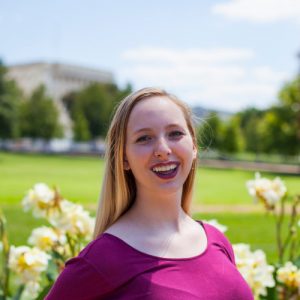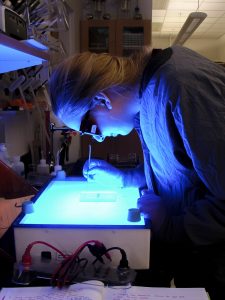Software Engineering senior graduates with dual degree to pursue interest in bioinformatics
Author: Lani McKinney
Author: Lani McKinney
Graduating senior Morgan Smith took STEM (Science, Technology, Engineering and Mathematics) to a whole new level after she arrived at Iowa State University. This fall, Smith, who is from Nevada, Iowa will graduate with two STEM degrees – Software Engineering (SE) from the College of Engineering and Microbiology (MICR) from the College of Agriculture and Life Sciences.
Originally enrolled as an SE major because of her interest in computers, Smith also had a strong interest in science. This dual interest prompted her to pursue a double major in SE and MICR – a challenging combination involving all aspects of STEM. “I’ve always had a passion for science… I fell in love with microbiology and started to see the opportunities for bioinformatics by combining my interest in computers and biology,” says Smith.
“I’d always had a passion for science… I fell in love with microbiology and started to see the opportunities for bioinformatics by combining my interest in computers and biology.”
Between high school and college in Summer 2016, Smith received an internship with the World Food Prize and the U.S. Department of Agriculture (USDA). Recipient of this prestigious USDA Wallace-Carver Fellowship, she was one of thirty-seven USDA-paid Wallace-Carver fellows stationed at USDA research centers and field offices across the country. Smith’s placement was with the US Agriculture Research Service (ARS), National Animal Disease Center in Ames, Iowa where she was a Wallace-Carver fellow in both 2016 and as a college student in Summer 2017.
Smith continued to work at the USDA for a few years before she began an independent study under the guidance of Dr. Chris Minion, a recently retired professor of veterinary microbiology and preventive medicine who worked at the College of Veterinary Medicine for over 30 years.
“One of my favorite projects has definitely been my work at Vet Med under Dr. Minion where I helped to sequence, assemble, and analyze 16 genomes of Mycoplasma hyopneumoniae isolates,” shares Smith, “Mycoplasma is the smallest discovered self-replicating organism and is just a really unusual and fascinating organism. To take the project from culturing bacteria all the way to a final genome was really cool to see, especially since that was one of my first experiences in bioinformatics. It’s what I’d like to continue to do post-graduation.”
With some encouragement and strong mentorship at both internships and student jobs, Smith found the courage to pursue both of her interests, but it wasn’t always easy. Diagnosed with dyslexia, a lot of people questioned her choice to pursue a Software Engineering degree. Coding, she says, can be more difficult with dyslexia. Her passion, though, helped her overcome difficulties. In fact, Smith says she feels her unique perspective made her more aware of how software can be used by or adapted to individuals with disabilities or unique situations which will help her in diversifying the field.
Smith is grateful for her experiences at ISU. “I like that students can choose their future,” she says. Outside of her lab work experience, Smith’s favorite involvement were the outreach opportunities she realized through Microbiology Club, WiSE (Program for Women in Science and Engineering), and with other groups where she was invited to present her experience to high school students interested in STEM.
What advice would she give to incoming students? Stay open. Take time to explore different opportunities. Involve yourself in things that interest you. Get out of your comfort zone. “If I hadn’t taken an internship that wasn’t related to my major, I wouldn’t have added a secondary major and my career path would be completely different.”


